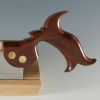My recent project and the thread about distressing have me thinking about how to age pine.
Pine (Eastern White Pine) over time acquires a rich brown/dark amber color that I very much like. I think it's the result of perhaps oxidation, but I'm not sure. It does not seem to depend on exposure to light as I've found many old studs that haven't seen light in decades but have darkened considerably. I also have some unfinished pine shop pieces that have grown dark over the course of just a few years. The look of old EWP is sometimes referred to (incorrectly) as "Pumpkin Pine".
Stains and dyes and glazes do not give this look. They reverse the grain, give a muddied or blotchy appearance. For oak and some other woods that are richer in tannins, I'd try ammonia fuming but pine is not a good candidate for this treatment.
My Google searches have not produced much. Has anyone here tried to expedite the darkening of pine with any success? Maybe to match old trim or simulate age in shaker or country furniture?





 Reply With Quote
Reply With Quote



